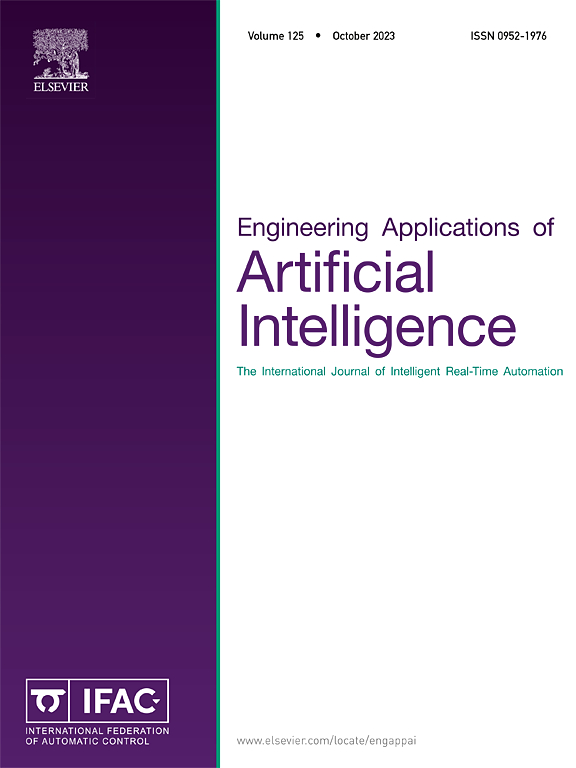CorNet:一种基于物理引导和注意机制的冠状动脉树流场预测深度学习方法
IF 8
2区 计算机科学
Q1 AUTOMATION & CONTROL SYSTEMS
Engineering Applications of Artificial Intelligence
Pub Date : 2025-07-02
DOI:10.1016/j.engappai.2025.111460
引用次数: 0
摘要
用深度学习技术取代传统的计算流体力学(CFD)已经成为研究血流和诊断疾病的一种流行方法。然而,目前还没有专门为树状血管结构设计的神经网络能够有效地捕获它们的分叉模式和分支依赖性。提出冠状动脉神经网络(CorNet)用于预测冠状动脉树的压力场和分流储备(FFRCorNet)。该框架的新颖之处在于利用自关注机制来解决维管树内的长期空间依赖性。我们的数据集包括273名患者的295棵冠状动脉树,每个树包括从医学图像重建的点云和通过CFD (FFRCT)计算的血流储备值。物理约束被纳入以减轻数据稀疏性并增强神经网络的可解释性。CorNet预测结果与CFD计算结果吻合较好(平均相对误差为3.96%)。FFRCT和FFRCorNet之间也有很好的一致性。与被认为是“金标准”的侵入性分数血流储备相比,FFRCorNet的准确性与FFRCT相当(88%对90%),同时将计算时间减少了数千倍。与以往的研究相比,CorNet消除了识别特定病变部位或手动提取狭窄节段几何参数的需要。这是第一个使用深度学习模型中的注意机制来预测三维血管树结构中的血流动力学的计算方法。我们预计这个框架将使动脉树的近实时流场预测成为可能,并为心血管疾病的治疗提供有价值的见解。本文章由计算机程序翻译,如有差异,请以英文原文为准。
CorNet: A deep learning method based on physics-guided and attention mechanism for predicting flow field of coronary arterial tree
Replacing traditional computational fluid dynamics (CFD) with deep learning techniques has become a prevalent approach for studying blood flow and diagnosing diseases. Nevertheless, no neural network has been specifically designed for tree-like blood vessel structures that can effectively capture their bifurcation patterns and branching dependencies. Coronary neural network (CorNet) was proposed for predicting the pressure field and fractional flow reserve (FFR) of the coronary artery tree. The novelty of this framework lies in utilizing self-attention mechanisms to address long-term spatial dependencies within the vascular tree. Our dataset comprised 295 coronary arterial trees from 273 patients, each including point clouds reconstructed from medical images and fractional flow reserve values calculated by CFD (FFR). Physical constraints were incorporated to mitigate data sparsity and enhance the interpretability of the neural network. The pressure results predicted by CorNet are consistent with the pressure calculated by CFD (mean relative error = 3.96%). There is also a good consistency between FFR and FFR.Compared to invasive fractional flow reserve, which is considered the “gold standard”, FFR demonstrates accuracy comparable to FFR (88% vs. 90%) while reducing computation time by several thousand-fold. Compared to previous studies, CorNet eliminates the need to identify specific lesion sites or manually extract geometric parameters of stenotic segments. This is the first computational method to predict hemodynamics in three-dimensional vascular tree structures using attention mechanisms within a deep learning model. We foresee that this framework will enable near-real-time flow field predictions for arterial trees and offer valuable insights for cardiovascular disease treatment.
求助全文
通过发布文献求助,成功后即可免费获取论文全文。
去求助
来源期刊

Engineering Applications of Artificial Intelligence
工程技术-工程:电子与电气
CiteScore
9.60
自引率
10.00%
发文量
505
审稿时长
68 days
期刊介绍:
Artificial Intelligence (AI) is pivotal in driving the fourth industrial revolution, witnessing remarkable advancements across various machine learning methodologies. AI techniques have become indispensable tools for practicing engineers, enabling them to tackle previously insurmountable challenges. Engineering Applications of Artificial Intelligence serves as a global platform for the swift dissemination of research elucidating the practical application of AI methods across all engineering disciplines. Submitted papers are expected to present novel aspects of AI utilized in real-world engineering applications, validated using publicly available datasets to ensure the replicability of research outcomes. Join us in exploring the transformative potential of AI in engineering.
 求助内容:
求助内容: 应助结果提醒方式:
应助结果提醒方式:


